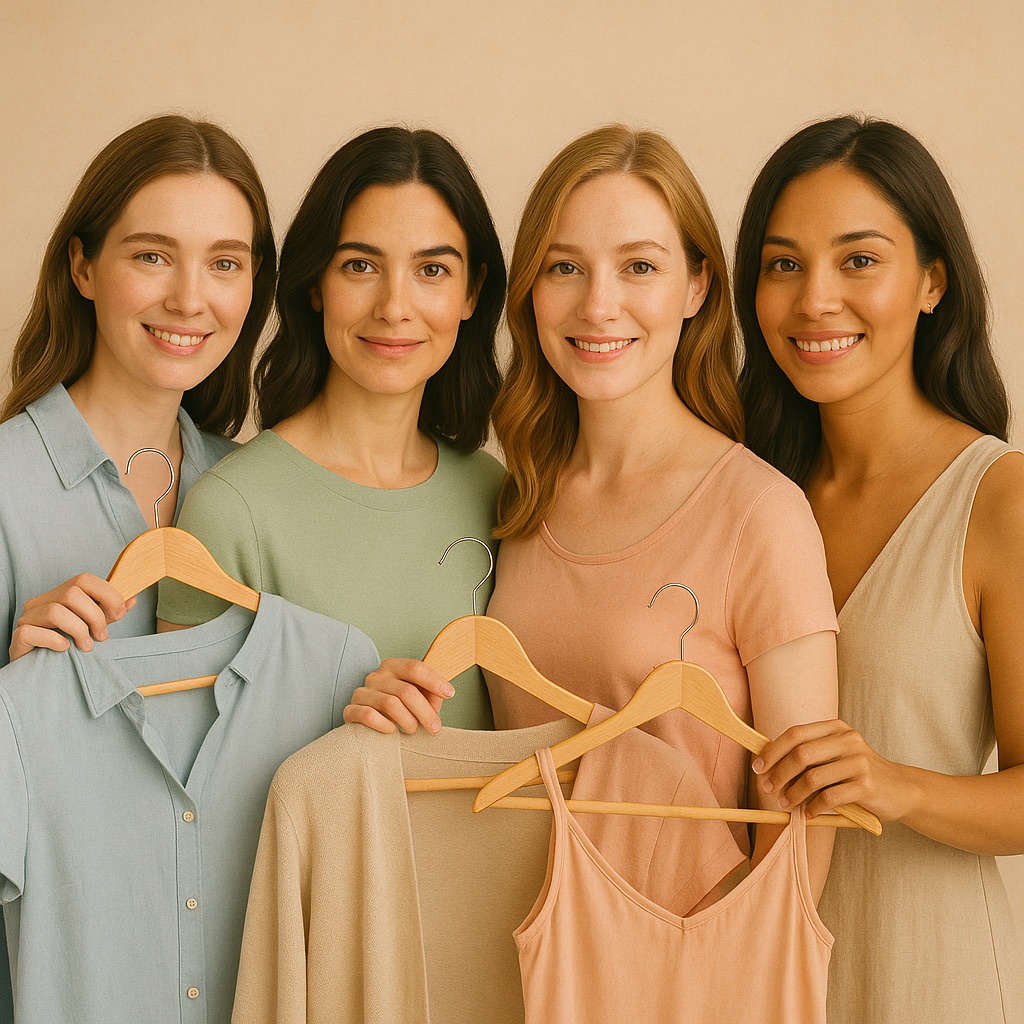What Material Should I Buy for Skirts? What I’ve Learned About Fabric, Fit and Why It Matters
Author: Stylist at TellarDate: 2025
When I used to shop for skirts, I thought the hard part was picking a length or print. Mini or midi? Plain or patterned? But I’ve realised the real question I should have been asking was: what’s it made from?
The material of a skirt makes or breaks everything—how it fits, how it drapes, how breathable it is, and most importantly, how it behaves on your body. I’ve bought skirts that looked amazing online but clung in the wrong places, creased after 20 minutes, or made me overheat in summer. Every time, the root cause was the same: I hadn’t considered the fabric.
So I decided to dig into what different skirt fabrics actually do—and how to shop smarter. Here’s everything I’ve learned, including how I now use tellar.co.uk to get the right fit in over 1,500 brands (without guessing sizes ever again).
Why Fabric Choice Is So Important
Let’s be honest: most of us shop with our eyes first. If a skirt looks great in photos, we’re sold. But the feel, weight and movement of a fabric are what really define how that skirt behaves once you’re wearing it.
Here’s what I now ask myself before I click “buy”:
Will this wrinkle five minutes after I sit down?
Is the fabric stiff or floaty—and which suits my shape better?
Can it handle a warm day without making me uncomfortable?
Is it lined, breathable, sustainable?
The good news? Once you understand what certain materials are good at (and not so good at), finding the perfect skirt gets much easier.
Cotton – Reliable, Breathable, and Easy to Wear
Cotton is a staple in my wardrobe—especially for everyday skirts. It’s soft, natural, and comfortable. I wear cotton midi skirts when I want something structured that still feels breathable. Brands like M&S and Uniqlo do great versions in poplin or stretch cotton.
But there are caveats. 100% cotton creases easily and offers little stretch, so if a skirt is fitted at the waist, I always double-check sizing using tellar.co.uk. I’ve also learned to look for cotton blended with elastane—it makes a huge difference in comfort and shape retention.
Viscose – My Favourite for Flowy, Feminine Shapes
When I want a skirt that moves—think wrap styles, bias cuts, or soft pleats—viscose is my go-to. It drapes beautifully and feels like silk, but without the dry-cleaning bill. I’ve found gorgeous viscose skirts at places like & Other Stories and Baukjen.
That said, viscose can be high maintenance. If you wash it on the wrong setting, it might shrink. And it’s fragile when wet. But if you’re willing to treat it with care, the feel and fall are so worth it.
Tip: I always check the product details—“viscose crepe” has more texture and thickness, whereas viscose satin is smoother and perfect for occasionwear.
Linen – Ideal for Summer, But Not Without Wrinkles
I have a love-hate relationship with linen. In summer, I reach for my linen midi skirts without hesitation. They’re cool, breathable, and effortless. Paired with a tank top and sandals, it’s the easiest warm-weather outfit. My favourites come from Massimo Dutti and Reiss.
The downside? Creasing. If you hate ironing, pure linen can drive you mad. I now look for linen-viscose or linen-cotton blends, which still breathe well but wrinkle less. They also feel softer straight away.
For sizing, especially in European brands, I always run the item through Tellar’s size lookup—it converts EU/UK sizes and checks if the waist-to-hip fit will actually work for my body.
Denim – Structured and Durable, but Choose Wisely
A great denim skirt is a staple—but only if the fit is right. I’ve owned stiff, unyielding ones that dug in, and stretchy ones that lost shape after a few wears. What I’ve learned? Stretch denim with 1–2% elastane is the sweet spot.
I love denim mini skirts for casual looks and denim midis for layering in spring and autumn. I’ve found good options at Levi’s and Mango—but sizing varies wildly between brands. That’s where tellar.co.uk has saved me from returns. Once you enter your measurements, it matches you to the correct size per brand—no more "I think I’m a 12 but maybe a 10 in this one?"
Polyester – Wrinkle-Free and Surprisingly Useful
I used to avoid polyester, but I’ve changed my mind—at least in some cases. For pleated skirts, structured styles, and machine-washable workwear, polyester is actually brilliant. It doesn’t wrinkle, it holds shape, and it’s easy to care for.
I have a pleated midi from Phase Eight that’s 100% polyester and still looks new after 20 washes. It’s especially handy for travel when you need clothes that hold up. Just be aware: cheaper polyester can feel stuffy, so I avoid it in hot weather.
Tencel – My Favourite Sustainable Fabric

If I could build my whole wardrobe from one fabric, it might be Tencel (also known as Lyocell). It’s sustainably made from eucalyptus fibres, feels like silk and cotton had a baby, and it’s breathable, antibacterial, and long-wearing.
Skirts in Tencel tend to be soft, fluid, and versatile. I’ve bought some great ones from brands like Nobody’s Child and Thought Clothing. They’re slightly more expensive, but the longevity makes up for it.
Tencel is also less prone to shrinking than viscose and handles moisture really well. It’s an ideal pick if you want a drapey feel with low impact on the planet.
What I Wear and When
Situation | Best Material (For Me) |
|---|---|
Casual weekend wear | Cotton or denim |
Hot weather / holidays | Linen or Tencel |
Workwear | Polyester crepe or stretch cotton |
Date nights / evenings | Viscose satin or Tencel |
Travel / low-maintenance | Polyester blends |
Sustainable choices | Tencel, organic cotton |
The Fit Factor: Why Fabric and Size Go Hand-in-Hand
Different materials sit on the body in different ways. A cotton skirt might be stiff at the waist, while viscose flows loosely. That’s why fabric is only half the equation—the fit matters just as much.
That’s where I now rely on tellar.co.uk. Instead of guessing my size in each brand, I entered my waist and hip measurements and let Tellar tell me which size fits best—whether it’s ASOS, Reiss, Mango or Hush. It’s fast, free, and honestly takes the stress out of shopping.
If I’m trying a new fabric (especially one with no stretch), I check Tellar first. No more “returns pile” in the hallway!
Final Thoughts: Fabric First, Fit Second
Buying the right skirt starts with understanding the fabric. Do you need structure or movement? Breathability or wrinkle-resistance? Do you want it to hug your figure or skim over it?
Now, I think of material as the foundation. Once that’s right, I check the size using tellar.co.uk, and finally—finally—I look at colours and styles. It’s completely changed how I shop.
If you’re sick of skirts that don’t fit or feel wrong after one wear, start by checking what they’re made from—and get the size right from the start.
Want to Make Skirt Shopping Easier?
🧵 Create your free Tellar profile here
🧵 Match your body to over 1,500 brands in seconds
🧵 Compare UK, US and EU sizing instantly
🧵 Shop by fabric, fit and brand—all in one place
Follow Tellar.co.uk for Fit, Fabric and Fashion Advice:
Instagram: @Tellarsizing
Twitter (X): @Tellar100
Pinterest: https://www.pinterest.co.uk/TellarUK
Facebook: https://www.facebook.com/TellarSizing
Tellar.co.uk – Find your size in 1,500+ brands real-time. It’s free & easy.
The Tellar Fashion Hub is the World's Largest, 100% Free, Fully searchable, Fashion Library. Filled with 4000+ Honest & Unbiased posts, written by our expert stylists.
No adverts, no sponsored posts, no subscriptions. We are 100% free to use.
We are paid by affiliates, but we never allow brands to influence our recommendations.
Honest, Unbiased, Accurate & Free.
